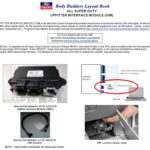Are you struggling to connect your OBDII scanner to your 2000 Nissan? You’re not alone! Many Nissan owners with models around the year 2000 have encountered a frustrating issue where their OBDII reader simply refuses to communicate with the vehicle’s computer. This can be particularly vexing when you’re trying to diagnose a check engine light or prepare for a smog test. One user stumbled upon a peculiar solution that might shed light on why your scanner isn’t linking up – and it all revolves around voltage.
The Curious Case of the 11.84V Threshold
This Nissan owner noticed a strange pattern while troubleshooting their OBDII connection. By measuring the voltage at the OBDII port (pin 16 for power and pin 4 for ground), they discovered something quite unexpected.
When the car sat overnight, the voltage reading at the OBDII port hovered around 11.8V to 11.84V. In this voltage range, the OBDII scanner connected flawlessly as soon as the ignition key was turned to the “ON” position. No communication problems whatsoever.
However, things took a turn after starting the engine. Once the car ran and the battery received a bit of charge, turning off the engine and switching the key back to “ON” resulted in a higher voltage reading at the OBDII port, typically above 12V, like 12.2V or more. In this higher voltage state, the OBDII scanner stubbornly refused to link.
The Brake Pedal and Headlight Hack: Lowering Voltage to Connect
This is where the troubleshooting gets interesting. The user observed that by pressing the brake pedal, the voltage at the OBDII port would slightly decrease, perhaps down to 12.02V. Even at this slightly reduced voltage, the scanner remained disconnected.
But then, a breakthrough! By further increasing the electrical load – pressing the brake pedal AND turning on the headlights – the voltage would drop a bit more, often landing around 11.84V. And just like magic, at this lower voltage, the OBDII scanner would establish a connection instantly!
It became clear that it wasn’t the brake pedal itself that was the solution, but rather the act of creating a significant electrical draw on the system. This draw was enough to reduce the voltage at the OBDII port to that critical 11.84V threshold, enabling communication.
This user confirmed that the scanner never connected when the engine was running, a state where the voltage at the OBDII port typically ranged from 14.2V to 14.4V due to the alternator charging the system.
Is Voltage Sensitivity the Culprit? Exploring Potential Causes
This discovery raises a significant question: Is the Engine Control Unit (ECU) or the OBDII system in this 2000 Nissan exhibiting voltage sensitivity? Could there be an internal voltage regulator issue that’s limiting power to the OBDII port or affecting the ECU’s communication protocols at higher voltages?
Here are some potential explanations to consider:
- ECU Voltage Regulator: Perhaps the ECU, or a component regulating power to the OBDII port, has a faulty voltage regulator. This could cause it to function correctly only within a narrow voltage range, specifically around 11.84V. At higher voltages, the regulator might be malfunctioning, disrupting communication.
- Wiring or Grounding Issues: While less likely to be voltage-dependent in this precise manner, wiring or grounding problems can sometimes manifest in unexpected ways. A poor ground or a slight wiring issue could be exacerbated at higher voltages, interfering with the OBDII communication signal.
- Scanner Compatibility: Although the user mentioned a generic OBDII scanner issue, it’s worth considering if certain scanners are more sensitive to voltage fluctuations than others. However, the consistent behavior across different scenarios in this case points more towards a vehicle-side issue.
Smog Check and Mechanic Insights
The user’s experience at a smog check station further reinforces this voltage theory. The smog technician’s computer linked successfully with the engine off and brake pedal pressed (likely dropping the voltage), but failed when the engine needed to be running for the actual smog test.
Interestingly, the user’s mechanic was able to connect using a Snap-on scanner, but only by manually entering vehicle data, bypassing the generic OBDII protocol. This suggests that while generic OBDII communication might be voltage-sensitive, more advanced scanners with specific vehicle protocols might be more resilient or operate differently.
Seeking Community Wisdom and Further Troubleshooting
This real-world observation provides a valuable starting point for anyone facing a “2000 Nissan Obdii Not Communicating With Reader” problem. If you’re experiencing this issue, try measuring the voltage at your OBDII port under different conditions, as described above.
Here are some steps to try:
- Voltage Measurement: Use a multimeter to measure the voltage between pin 16 (power) and pin 4 (ground) of your OBDII port with the ignition key in the “ON” position and engine OFF. Note the reading.
- Load Test: Repeat the voltage measurement while applying an electrical load, such as pressing the brake pedal and turning on the headlights. Observe if the voltage drops and if your OBDII scanner connects in this lower voltage state.
- Battery Condition: Check your battery’s health. While the issue appears voltage-related rather than solely battery-related, a weak or failing battery could contribute to voltage instability.
- Professional Diagnosis: If you confirm this voltage sensitivity, it’s highly recommended to consult a qualified mechanic specializing in automotive electronics. They can perform more in-depth diagnostics to pinpoint the root cause, whether it’s a faulty voltage regulator, ECU issue, or wiring problem.
Have you encountered a similar OBDII communication problem with your 2000 Nissan or other vehicles of that era? Share your experiences and insights in the comments below! Your contributions can help others in the community troubleshoot and resolve this frustrating issue.

